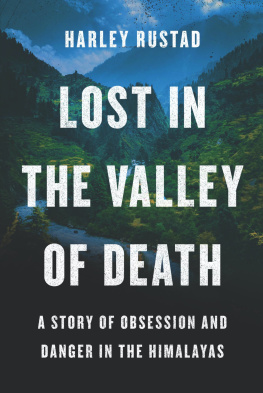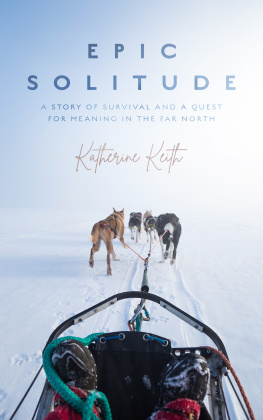Contents
Contents
Guide
Print Page List
For lise
Death is not extinguishing the light; it is only putting out the lamp because the dawn has come.
Rabindranath Tagore, Indian poet
Contents
The traveler had all that he needed inside his cave. It wasnt much but enough to survive. He reclined against the granite wall, bare back meeting cold stone. He had collected fallen wood, anything half dry, from the forest around his cave, stripping some logs into kindling with his machete, and set about lighting a fire. He positioned it near the mouth of the cave so the noxious smoke would dissipate into the night and animals would be deterred from entering. He opened a book; there was just enough light in which to read. It was a book about the search to find happiness in the world.
His cave lay in a forest deep in the Indian Himalayas, a half days walk from the nearest village or the nearest road, near the head of a slender valley. There were dozens of caves in this forest that had formed in the lee of boulders or by great stones fracturing apart to create caverns. Many caves were tall enough in which to stand and long enough in which to lie down. Some boulders were said to have been dropped by the gods, as who else could move such colossi of stone, while others had been left behind by similarly powerful forces of nature, great glaciers that had retreated up the valley long before. Many people had walked by these caves without a second glance. But over the years, pilgrims and travelers of a certain type had found sanctuary in them, refuge from the elements or the world beyond. This traveler had sought out a cave. It was why he had come to this valley: to find a place in which to retreat and think about his life.
There is power in the Himalayas many mountaintops. They are purpose made stone, offering paths to realization and a sense of profound achievement of strength, determination, and will at their tops. Mountains have long served as endpoints of pilgrimages: to Mount Everest straddling the NepalChina border, to Mount Kailash on the Tibetan Plateau, and to Mount Meru in the Indian Himalayas, often called the navel of the universe. Summits offer perspective, a chance to look back down at your footprints with clarity. Yet for every mountain there is a valley residing below. If the expanse of a desert humbles and the restriction of a forest disorientates, the intimacy of a valley comfortsproviding tranquility and a shield from the forces of exposure. In valleys, thoughts dont float away across an ocean or a plain, never to return; they remain to be incubated. Around the world, seekers climb mountains to achieve that clarity or to be closer to their gods, but it is the valleys below in which their intentions solidify and from which they take their first steps. In these sanctuaries pilgrims can bask in the possibility of what lies ahead and above.
In his cave in the valley the traveler crossed his legs and warmed his feet near the fire, drying his black leather boots at the same time. He drank water that he had collected from a nearby spring out of a metal mug, one of the few items he had brought with him. He ate some nuts, dried fruit, and oats that he had purchased at a market down valley and threw a log on the fire. Beside him lay a long bamboo flute that he played during the daytime while sitting in a meadow overlooking the valley below; throughout his travels in India, he had carried it wherever he went. On a rock shelf next to him was a bulls horn that he had collected from the forest outside, as well as a large black feather that had fallen to earth from a Himalayan condor. Not long before, the traveler had tattooed the outline of an eagle in flight across his chest.
Eventually, he lay down on a bed of collected tree needles. Inside the cave there was light, a warm orange glow from his crackling fire and a single candle that he had melted onto the rock by which to read. But the world outside was dark. Thick canopies of pine, walnut, and deodar, a species of aromatic Himalayan cedar, blocked the moon; only the rain found a way through the branches. It was late summer, and the monsoon, in an instant, would shift from a drizzle to a torrent, pelting the mountains and blanketing the valley in heavy mist.
Every year, as consistent as the monsoon, pilgrims and travelers had come to this remote corner of India. They had come to find peace and tranquility, what a Hindi speaker calls shanti. They had come to breathe mountain air, to walk ancient forests, and to hike through a valley in the most storied mountain range on earth. They had come to be closer to the gods in a place where Shiva, the most iconic deity in the Hindu pantheon, the great master of yoga and asceticism and the supreme transformer of the world, is said to have meditated for three thousand years. Some of the visitors had traveled peacefully, departing satisfied with their experience and keen to tread elsewhere. But others had not.
The Parvati Valley is a seemingly idyllic corner of Himalayan India, with its big mountain vistas, forested glens, and quaint timber-framed villages clinging to its hillsides. It splinters off a part of the Kullu Valley, also known as the Valley of Gods. Named after a goddess itself, the Parvati Valley hosts its own compendium of legends and mystical stories, a place where gods manifest as dynamic rivers and their actions bring hot springs from deep underground to the surface. But the Parvati Valley has earned its own nicknames: the Valley of Shadows, the Valley of Death. It is a place where every movement exists on a knife edge, where a wrong turn tips a vehicle over an unbarriered cliff edge, a wrong step pitches a traveler into the churning maelstrom of the river, a wrong turn sends a hiker to ranges unknown. Since the early 1990s, dozens of international backpackers have vanished without a trace while traveling in and around the Parvati Valley, an average of one every year, earning this tiny, remote sliver of the subcontinent a dark reputation as Indias backpacker Bermuda Triangle. The circumstances of each disappearance are differentthe tourists country of origin; villages visited or paths walked; last known locationyet eerily similar. All feature a spirited backpacker seeking an off-the-beaten-track adventure, a collection of anecdotes from fellow travelers relating the backpackers final days, a familys anguished search, and thousands of unanswered questions.
This traveler had arrived in the Parvati Valley as many before him had: with a goal and a picture in his mind of what he could accomplish among the mountains and the mist. That picture, at least in part, came to life inside his cave when he carefully placed his phone on a rock, set the timer, and captured a self-portrait as he reclined with his book and his fire. It was one of the last photographs he shared online with his followers on social media. Shortly thereafter, the travelers name, Justin Alexander Shetler, would be added to the list of those who had entered the Parvati Valley never to be seen again.
Rise, wake up, seek the wise and realize. The path is difficult to cross like the sharpened edge of a razor, so say the wise.
Katha Upanishad, Sanskrit text
Tell me something you are dedicated to in life and a true test of that dedication is, Would you die for it?
Stalking Wolf, as quoted by Tom Brown, Jr.
There is only one road into the Parvati Valley. Its a narrow trackroughly paved in parts, washed-out dirt in othersalong which rattletrap buses twist and swerve and screech to a crawl with inches to spare as they pass. At several points, vehicles drive under overhanging rock along a route blasted into the mountainside. On one side of the road, the cliff rises, an impassable plane of earth and stone that seemingly touches the clouds; on the other side, it drops precipitously to the milky blue waters of the Parvati River hundreds of feet below. It was at the end of this road but the beginning of a path that Justin set off on his final journey. The hillside hamlet of Kalga was as far as his Royal Enfield motorcycle could take him. He now needed to walk to reach the upper reaches of the valley. The trail into the mountains was clear before him: follow the godlike river that thrashed and thundered in his ears.









